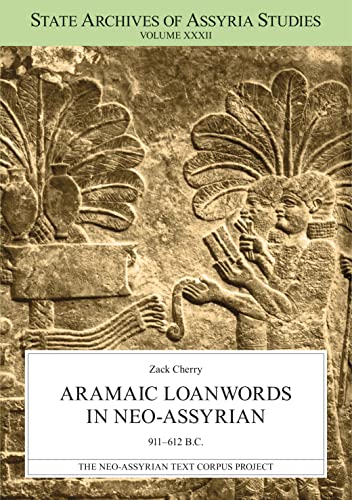Verwandte Artikel zu Aramaic Loanwords in Neo-Assyrian 911–612 B.C....

Inhaltsangabe
This study identifies and analyzes Aramaic loanwords occurring in Neo-Assyrian texts between 911 and 612 B.C. As two Semitic languages, Neo-Assyrian and Aramaic are sibling-descendants of a postulated common ancestor, Proto-Semitic. The work provides information about the contact between the two languages and about the people who spoke them.
To achieve this scholarly objective, a total of 9,057 Neo-Assyrian texts of different genres were utilized. The study discusses 166 proposed Aramaic loanwords in Neo-Assyrian, which are evaluated according to phonological, morphological, and semantic criteria. The findings demonstrate that only 69 words are confirmed loanwords, and 50 are possible loanwords. Additionally, 47 words are rejected as possible Aramaic loanwords in Neo-Assyrian. The majority of the confirmed loanwords are attested in letters and legal and administrative documents from the seventh century B.C., stemming from the major Assyrian cities of Nineveh, Assur, and Calah. Most of the confirmed loanwords are nouns.
Aramaic was the lingua franca of the Neo-Assyrian Empire from the mid-eighth century B.C. onwards, and the loanwords analyzed provide evidence for the use of Aramaic in Assyria proper as well. The relatively small number of certain and possible loanwords, however, fails to support the impression that Aramaic was widespread as a vernacular language in Assyria proper, especially towards the end of the period studied. The evidence also corroborates the conclusion, based on the extant prosopographical data, that the predominantly Assyrian character was maintained in Assyria proper until the very end of the Assyrian Empire.
Die Inhaltsangabe kann sich auf eine andere Ausgabe dieses Titels beziehen.
Über die Autorin bzw. den Autor
Zack Cherry is in the Department of Linguistics and Philology at Uppsala University.
„Über diesen Titel“ kann sich auf eine andere Ausgabe dieses Titels beziehen.
EUR 4,29 für den Versand innerhalb von/der USA
Versandziele, Kosten & DauerNeu kaufen
Diesen Artikel anzeigenEUR 6,72 für den Versand von Vereinigtes Königreich nach USA
Versandziele, Kosten & DauerSuchergebnisse für Aramaic Loanwords in Neo-Assyrian 911–612 B.C....
Aramaic Loanwords in Neo-Assyrian 911â"612 B.C. (State Archives of Assyria Studies)
Anbieter: Books From California, Simi Valley, CA, USA
paperback. Zustand: Fine. Artikel-Nr. mon0003305828
Anzahl: 11 verfügbar
Aramaic Loanwords in Neo-Assyrian 911â"612 B.C. (State Archives of Assyria Studies)
Anbieter: Books From California, Simi Valley, CA, USA
paperback. Zustand: Very Good. Artikel-Nr. mon0003349773
Anzahl: 7 verfügbar
Aramaic Loanwords in Neo-Assyrian 911-612 B.C.
Anbieter: PBShop.store UK, Fairford, GLOS, Vereinigtes Königreich
PAP. Zustand: New. New Book. Shipped from UK. Established seller since 2000. Artikel-Nr. FW-9789521095047
Anzahl: 15 verfügbar
Aramaic Loanwords in Neo-Assyrian 911-612 B.C. (State Archives of Assyria Studies)
Anbieter: Ria Christie Collections, Uxbridge, Vereinigtes Königreich
Zustand: New. In. Artikel-Nr. ria9789521095047_new
Anzahl: Mehr als 20 verfügbar
Aramaic Loanwords In Neo Assyrian 91161
Anbieter: Kennys Bookstore, Olney, MD, USA
Zustand: New. 2023. Bilingual. paperback. . . . . . Books ship from the US and Ireland. Artikel-Nr. V9789521095047
Anzahl: Mehr als 20 verfügbar
Aramaic Loanwords in Neo-Assyrian 911-612 B.C.
Anbieter: Majestic Books, Hounslow, Vereinigtes Königreich
Zustand: New. Artikel-Nr. 399986847
Anzahl: 3 verfügbar
Aramaic Loanwords in NeoAssyrian 911612 B.C.
Anbieter: Revaluation Books, Exeter, Vereinigtes Königreich
Paperback. Zustand: Brand New. bilingual edition. 389 pages. 9.50x6.75x1.00 inches. In Stock. Artikel-Nr. __9521095040
Anzahl: 2 verfügbar
Aramaic Loanwords in Neo-Assyrian 911-612 B.C. (SAAS 32)
Anbieter: Ruslania, Helsinki, Finnland
Zustand: new. Pages: 414 Language: English. Neo-Assyrian Text Corpus Project, SAAS XXXII This study identifies and analyzes Aramaic loanwords occurring in Neo-Assyrian texts between 911 and 612 B.C. As two Semitic languages, Neo-Assyrian and Aramaic are sibling-descendants of a postulated common ancestor, Proto-Semitic. The work provides information about the contact between the two languages and about the people who spoke them. This study identifies and analyzes Aramaic loanwords occurring in Neo-Assyrian texts between 911 and 612 B.C. As two Semitic languages, Neo-Assyrian and Aramaic are sibling-descendants of a postulated common ancestor, Proto-Semitic. The work provides information about the contact between the two languages and about the people who spoke them. To achieve this scholarly objective, a total of 9,057 Neo-Assyrian texts of different genres were utilized. The study discusses 166 proposed Aramaic loanwords in Neo-Assyrian, which are evaluated according to phonological, morphological, and semantic criteria. The findings demonstrate that only 69 words are confirmed loanwords, and 50 are possible loanwords. Additionally, 47 words are rejected as possible Aramaic loanwords in Neo-Assyrian. The majority of the confirmed loanwords are attested in letters and legal and administrative documents from the seventh century B.C., stemming from the major Assyrian cities of Nineveh, Assur, and Calah. Most of the confirmed loanwords are nouns. Aramaic was the lingua franca of the Neo-Assyrian Empire from the mid-eighth century B.C. onwards, and the loanwords analyzed provide evidence for the use of Aramaic in Assyria proper as well. The relatively small number of certain and possible loanwords, however, fails to support the impression that Aramaic was widespread as a vernacular language in Assyria proper, especially towards the end of the period studied. The evidence also corroborates the conclusion, based on the extant prosopographical data, that the predominantly Assyrian character was maintained in Assyria proper until the very end of the Assyrian Empire. 9789521095047. Artikel-Nr. 10-1775106
Anzahl: 2 verfügbar
Aramaic Loanwords in NeoAssyrian 911612 B.C.
Anbieter: moluna, Greven, Deutschland
Zustand: New. Über den Autor Zack Cherry is in the Department of Linguistics and Philology at Uppsala University.KlappentextThis study identifies and analyzes Aramaic loanwords occurring in N. Artikel-Nr. 830757367
Anzahl: Mehr als 20 verfügbar
Aramaic Loanwords in Neo-Assyrian 911-612 B.C.
Anbieter: AHA-BUCH GmbH, Einbeck, Deutschland
Taschenbuch. Zustand: Neu. Neuware - This study identifies and analyzes Aramaic loanwords occurring in Neo-Assyrian texts between 911 and 612 B.C. As two Semitic languages, Neo-Assyrian and Aramaic are sibling-descendants of a postulated common ancestor, Proto-Semitic. The work provides information about the contact between the two languages and about the people who spoke them. Artikel-Nr. 9789521095047
Anzahl: 2 verfügbar
